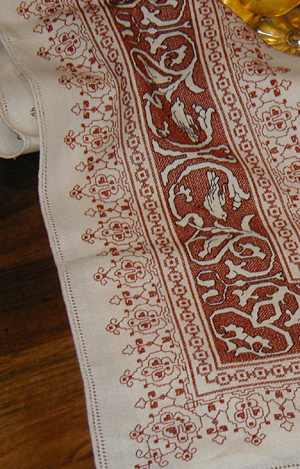|
Assisi,
city of Peace and Prayer , can also be called the
city of work. Following the example of Chiara degli
Scifi, Sainte Claire of Assisi. Many women came
there to found peace on the shadow of contemplative
cloisters, sharing the day between work and prayer.
About all the convents keep in their sacristies
treasures of sacred linens and table clothes , looking
to their they seem made by the hands of faiths.
In the quiet cloistered laboratories, the gentle
Franciscan legend is always a large source of inspiration.
The tapestries, panels and the table clothes used
the divine cult, are reproducing in their boards
the delicate ornaments inspired of the scene painted
in the frescoes of Giotto and Simone Martini. According
to the change of time the problem of life is becoming
more obsessing, the women assume a major role and
also more difficult, taking an important part in
the hard fight for life, with an artistic work.
This work passed from the silent cloisters to the
simple homes and so gave to young women independence
and work. Every city tried to get from his past
a particular work, even Assisi joined the others
cities in order to find the style more adapted to
its soul. Nobel women rummaged in the chest in the
ancient patrician houses , in the cloisters in the
sacristies of the major churches and in the oratories,
closed in the green of the fertile coast, they reproduced
with meticulous accuracy the primitive drawings
of the 13 th and 14th centuries, even in the coarse
ingenuousness of the line, others from the 15th
and 16th centuries always more elegant and perfect.
The divine frescoes , the portals the linear choir
finely carved. With its faded ivory pallor, the
rolls of cloth had to imitate old canvas, the embroidery
has to be so close as possible to the traditional
colours, rust brown and and blue, the drawing do
not lost its rectilinear character. The genial experience
can not have a more happy end, the embroidery linen
with “Punto assisi” made with care in
all details, soon got out the urban walls and join
others cities in Italy and also brought in foreign
countries even over the ocean the beauty of an ancient
art and history conjugated in a female way, grateful
for the delicate blue roses embroidered by Jacopa
de’ Settesoli, piously close with the saint
of Assisi, the poorest Saint, the holiest poor.
During the 19th and the 20th centuries the art of
embroidery called Punto Assisi became more elegant,
many different technical centres, as “Il laboratorio
S. Francesco, the Cooperative C.A.R.A., the centre
of embroidery is there that after the two world
wars, many young women learn this art. Today lessons
of embroidery of Punto Assisi and lessons of embroidery
Madama Caterina are made by the Academy Punto Assisi
with the intent to offer to the young and less young
people the possibilities to learn an excellent art
which is disappearing, (also supplanted by the machine),
the opportunities of a change, experiences, dialogue,
collaboration socialization and a point meeting
under the sign of an elegant womanly art. |
 |

